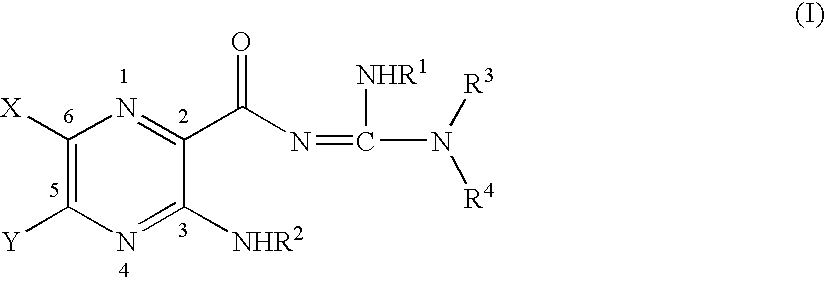Sodium channel blockers
- Summary
- Abstract
- Description
- Claims
- Application Information
AI Technical Summary
Benefits of technology
Problems solved by technology
Method used
Image
Examples
example 1
4-{4-[N-(3,5-diamino-6-chloropyrazine-2-carbonyl)guanidino]butyl}-N-(2-aminoethyl)benzamide Hydrochloride (11698)
[0264]
4-(4-Aminobutyl)benzoic Acid (30)
[0265] A solution of sodium hydroxide (0.69 g, 17.37 mmol) in water (30 mL) was added to a solution of 24 (1.2 g, 5.79 mmol) in methanol (30 mL) and stirred at room temperature for 48 h. Then the solvent was removed under reduced pressure. Water (20 mL) was added and pH was adjusted to 7 with HCl. The white solid precipitate was filtered off, washed with water and dried in vacuum. The crude product 30 (1.39 g) was obtained as a white solid and used for the next step without further purification.
4-(4-Benzyloxycarbonylaminobutyl)benzoic Acid (31)
[0266] Sodium hydrogencarbonate (0,95 g, 11.32 mmol) was added into a suspension of 30 in THF (120 mL), followed by water (10 mL), affording a clear solution. Benzyl chloroformate (1.21 mL, 8.49 mmol) was then added into the reaction mixture at 0° C. The reaction mixture was then stirred at...
example 2
4-{4-[N′-(3,5-diamino-6-chloropyrazine-2-carbonyl)guanidino]butyl}-N-(2-guanidinoethyl)benzamide Hydrochloride (11834)
[0271]
4-{4-[N′-(3,5-Diamino-6-chloropyrazine-2-carbonyl)guanidino]butyl}-N-[2-N″,N′″-di-(butyloxycarbonylguanidino-ethyl]benzamide (36)
[0272] Triethylamine (0.34 mL, 2.44 mmol) was added into a suspension of 35 in methanol (25 mL). The reaction mixture was stirred at room temperature for 20 min; at which time the suspension became a clear solution. N,N′-di-(tert-butoxycarbonyl)-N″-trifluoromethansulfonylguanidine (Goodman's reagent) (0.193 g, 0.489 mmol) was added into the reaction. The reaction mixture was stirred at room temperature for additional 6 h, after that the solvent was removed under reduced pressure and the residue was purified by Flash™ (BIOTAGE, Inc) (90 g silica gel cartridge 40M, 6:1:0.1 chloroform / ethanol / concentrated ammonium hydroxide) to provide 36 (0.18 g, 80%) as a yellow solid. 1H NMR (300 MHz, DMSO-d6) δ 1.40 (s, 9H), 1.47 (s, 9H), 1.52 (m, ...
example 3
N-(3,5-diamino-6-chloropyrazine-2-carbonyl)-N′-{4-[4-(3-guanidino-2-hydroxypropoxy)phenyl]butyl}guanidine Hydrochloride (11975)
[0274]
[0275] The synthesis of [4-(4-allyloxyphenyl)butyl]carbamic acid benzyl ester (38) was described in the previously provided experimental details (as compound 30).
[4-(4-Oxiranylmethoxyphenyl)butyl]carbamic Acid Benzyl Ester (39)
[0276] 3-Chloro-peroxybenzoic acid (2.46 g, 14.25 mmol) was added into a methylene chloride solution (100 mL) of 38 (1.86 g, 5.48 mmol), and the reaction was stirred at room temperature overnight. After that, the solvent was removed under reduced pressure and the residue was purified by flash chromatography (silica gel, 8:1:1 methylene chloride / hexane / ethyl acetate). To eliminate the admixture of benzoic acid the methylene chloride solution of the product was sequentially washed with a saturated aqueous solution of sodium hydrogen carbonate and water, then dried over anhydrous sodium sulfate and evaporated to provide 1.4 g (72...
PUM
| Property | Measurement | Unit |
|---|---|---|
| Pressure | aaaaa | aaaaa |
| Hydration number | aaaaa | aaaaa |
Abstract
Description
Claims
Application Information
 Login to View More
Login to View More - R&D
- Intellectual Property
- Life Sciences
- Materials
- Tech Scout
- Unparalleled Data Quality
- Higher Quality Content
- 60% Fewer Hallucinations
Browse by: Latest US Patents, China's latest patents, Technical Efficacy Thesaurus, Application Domain, Technology Topic, Popular Technical Reports.
© 2025 PatSnap. All rights reserved.Legal|Privacy policy|Modern Slavery Act Transparency Statement|Sitemap|About US| Contact US: help@patsnap.com



